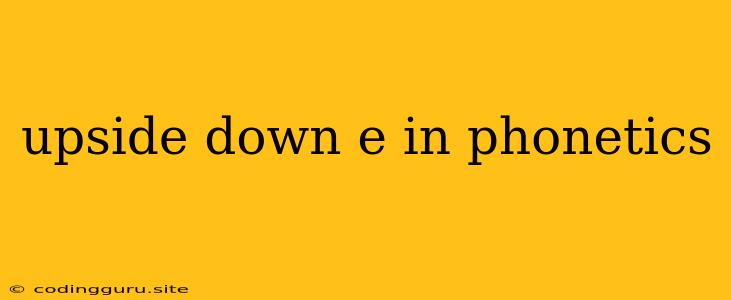The Upside-Down 'e' in Phonetics: A Guide to Understanding the Symbol
Phonetics is the study of speech sounds, and it utilizes a variety of symbols to represent these sounds. One such symbol, the upside-down 'e' (ə), often causes confusion for beginners. This symbol, known as the schwa, is a crucial element of understanding the sounds of English, particularly for pronunciation.
Why the Upside-Down 'e'?
The schwa represents a very common sound in English, but it doesn't have a dedicated letter in the alphabet. It's often described as a "short, unstressed vowel sound" and is often the sound you hear in the middle of words like "about", "sofa", or "again". The upside-down 'e' is chosen for the schwa because it looks like a shortened 'e', indicating a reduced vowel sound.
How to Pronounce the Schwa
The schwa is a very short and neutral vowel sound. It doesn't have a strong, distinct quality like the vowel sounds in words like "cat", "dog", or "tree". Imagine saying "uh" very quickly, barely moving your tongue. This is the closest approximation to the schwa sound.
Here are some tips for understanding and pronouncing the schwa:
- Focus on the word's stress: The schwa usually occurs in unstressed syllables. The stress of a word indicates the syllable that receives the most emphasis.
- Listen to native speakers: Pay attention to how native English speakers pronounce words with the schwa. You'll notice that the sound is often very subtle and quick.
- Practice with examples: Words like "about", "sofa", "again", "the", "a" all have schwa sounds. Try saying these words and pay attention to the sounds you're making.
Why is the Schwa Important?
The schwa sound is essential for correct English pronunciation. It affects the rhythm and intonation of language. Mispronouncing words with the schwa can lead to miscommunication. It's also important for understanding the transcriptions of words in dictionaries and phonetic charts.
For example:
The word "again" is transcribed as /əˈɡen/. This transcription tells us that the first syllable has a schwa sound and the second syllable is stressed.
The Schwa in Different Languages
The schwa sound isn't exclusive to English. It exists in many other languages as well, though its pronunciation and use might differ. While the symbol may be the same, the sound itself might be slightly different based on the language and its phonetic rules.
Mastering the Schwa
Learning to pronounce the schwa correctly can be a challenge. It's a very subtle sound and takes practice. Be patient and consistent with your practice. The upside-down 'e' might seem daunting at first, but once you understand its role in pronunciation, it becomes an important tool for improving your English fluency.
Here are some helpful tips for mastering the schwa:
- Record yourself speaking: This allows you to hear your pronunciation and identify any errors.
- Practice with a partner: Having someone else listen to your pronunciation can help you identify areas for improvement.
- Use online resources: There are many websites and apps that offer pronunciation exercises and practice materials.
Conclusion
The upside-down 'e' or schwa may appear intimidating at first, but it is essential for accurate pronunciation in English. Understanding its function and mastering its sound is a crucial step towards fluency. As you continue practicing and learning, you'll develop a deeper understanding of the schwa and its importance in the world of phonetics.
